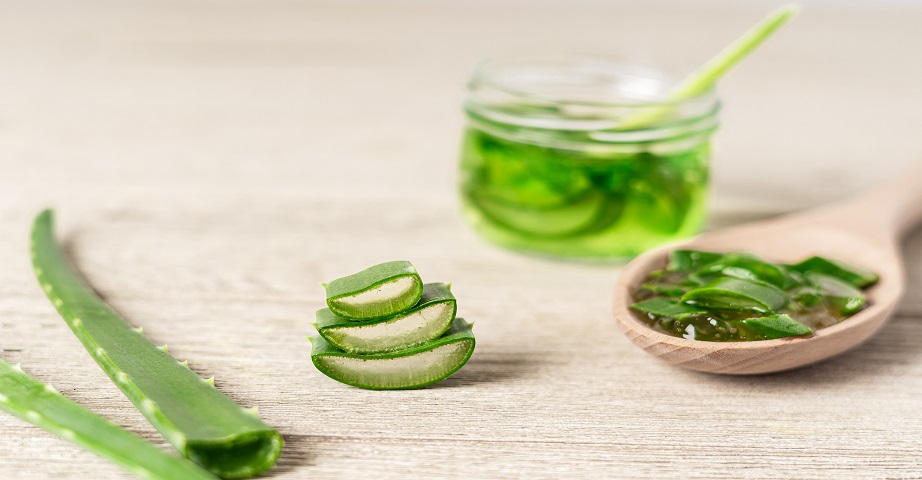Aloe - properties and use of the plant

Aloe is a plant that has distinguished considerable interest among consumers around the world in recent years. Scientific research confirms many valuable health-promoting properties of the plant, and aloe itself has found wide application in various areas of life, including cosmetology and stomatology. What specific properties does the plant have? How does aloe affect the human body and is it worth using it? Is aloe safe?
History of aloe
Aloe by the Greeks was called "Aloeh", or "bitter substance", while the Egyptians and Arabs called it "Sabr", or "bitter medicine". The nomenclature used resulted from the fact that in the past the flesh of aloe was consumed with its skin, which is distinguished by its bitter taste.
The first mention of the aloe, informing about its laxative properties, comes from the XVIII year BC, while in the Egyptian pyramids can be found hieroglyphs about the plant. In the Ebers papyrus, also called the Book of Medicines, which dates from 1550 BC, there are references to the medicinal use of the plant. However, the aloe was already in antiquity more than just a medicine. The plant was also used as a cosmetic, a component of lotions and creams, as well as a substance for mummifying corpses. Ramses II used aloe enemas to rinse the intestines, while Cleopatra used baths in donkey milk with the addition of a valuable plant.
It is believed that the trade in the aloe began in Arab culture, offering it to consumers as a laxative, as well as aiding digestion and wound healing. At that time, the plant was also considered a symbol of immortality and was worshipped. At the turn of IX and X century A.D., in the first medical school, the aloe was promoted as a means of helping with skin, eyes and stomach ailments. St. Hildegard of Bingen promoted the plant as a cough medicine. It was then that the aloe began to appear in monasteries, from where he then went to noble manors and peasant villages.
Over the years, more and more scientific research has been conducted focusing on the aloe and its properties. In the XX century it was found that the plant can reduce the risk of irradiation, and then its beneficial effect on eye diseases and the regeneration of digestive tissues was confirmed. In subsequent years, it was found that the aloe may inhibit the multiplication of unfavourable microorganisms in the body, and in 1990 was established the National Scientific Council for. Aloe (NASC), whose task is to confirm the quality of aloe preparations.
In 2022, the Chief Sanitary Inspector and the European Office for. Food Safety (EFSA) has put the aloe extract on the list of banned substances that should not be used in food and dietary supplements, due to possible genotoxic effects.
The history of the plant is long and turbulent... What is aloe exactly? What properties can it show?
Aloe - what is it?
Aloe is a perennial plant. It is a succulent that has branched, evergreen and fleshy leaves. It comes from Mediterranean countries, but it can also be found in tropical and subtropical climates. The aloe grows best on permeable peat soil mixed with sand and clay. It is easy to grow and has about 400 different species. The most popular variety of medicinal aloe is aloe vera (from latin aloe vera), but can be often also found varieties such as tree aloe (from lat. aloe arborescences) or cape aloe (from latin aloe ferox).
Among the aloe can distinguish edible and inedible species. In Poland, the aloe vera is considered edible, which is distinguished by green and smooth leaves. The inedible variety has a dark green colour and characteristic white spots.
Aloe when it blooms, and this happens at the end of winter, when the length of the day is about 10 hours, it has a long, red or orange perianth that is rich in nectar. Interestingly, it is the repeated flowering that distinguishes the aloe from agave, which blooms only once in a lifetime and then dies.
Aloe - values and nutrients
The aloe is a plant full of valuable nutrients. Its leaves are filled with a gel substance, which is 95% water, and the remaining 5% of its weight are active ingredients. It is believed that up to 75 different biologically active substances can be found in the plant.
The aloe contains, among others.:
- small amounts of fatty acids, including remarkable gamma-linolenic acid (GLA),
- amino acids, such as alanine, arginine, glutamic acid, leucine or methionine,
- vitamins, such as vitamin A, C or B vitamins, among others, folic acid,
- minerals, such as chromium, calcium, magnesium, iron, potassium,
- saponins, lignins and carbohydrates,
- natural salicylic acid,
- anthraquinones,
- acemannan,
- cinnamic acid,
- phenols,
and each part of the plant (skin, latex and aloe pulp) is characterized by a different composition of bioactive compounds and a slightly different pro-health effect. The composition of the leaves of the plant also depends on the conditions of its cultivation, as well as the season of harvest, the method of harvesting and geographical location.
Aloe properties
The aloe consists of chemical compounds such as glutathione peroxidase and superoxide dismutase, as well as antioxidant components such as vitamin C and E, which make the plant antioxidant. Thus, the aloe can neutralize free radicals and fight reactive oxygen species and reduce oxidative stress and delay aging processes.
Some scientific studies also indicate that the aloe extract may have anti-diabetic and hypoglycemic effects. Supplementation with aloe gel may also contribute to lowering the level of total cholesterol in the blood serum and promote a decrease in the concentration of its LDL fraction, called "bad" cholesterol.
In addition, the aloe can stimulate the immune system, increasing the viability of macrophages and causing an increase in their effectiveness in defense against pathogens. The plant can also accelerate the production of cytokines, which are responsible for the immune response.
Recent data also confirms the protective effect of aloe on the skin exposed to radiation. Prophylactic use of the plant can reduce the risk of radiation dermatitis, which can be helpful especially among oncological patients. Moreover, the active substances present in the aloe can relieve pain and accelerate the healing process of wounds, including by increasing the synthesis and amount of collagen. The action can also be helpful in the case of bedsores or sunburn. Research indicates that the aloe may have a more effective effect than commonly used in the case of burns, silver sulfadiazines, thanks to which it can positively affect the regeneration of the epidermis.
The aloe is a plant with anti-inflammatory properties that can participate in the production of hyaluronic acid. Preparations containing the extract of the plant can reduce inflammatory and non-inflammatory skin lesions, and thus can support the fight against acne. The aloe can also have cleansing, moisturizing and astringent properties, and can also support the maintenance of proper skin elasticity.
The plant is also used to combat conditions related to the digestive system. The aloe extract can alleviate conditions associated with irritable bowel syndrome (IBS), as well as reduce intestinal problems. Due to its antibacterial activity, the aloe can also be a support in the treatment of gastric ulcers, and what is more, it can alleviate the symptoms of reflux, such as heartburn, belching or regressing of the stomach contents to the esophagus. In addition, the aloe may have hepatoprotective properties, reducing the risk of cirrhosis and damage associated with excessive consumption of analgesics. As if that were not enough, the plant can act antiviral and antifungal.
The aloe can also have a beneficial effect on the oral cavity, reducing inflammation of the gums, as well as the plaque index. Thus, it can be helpful in combating tooth decay. The aloe may also lower the number of Candida albicans yeasts by supporting candidiasis therapy.

How to use aloe?
The aloe, due to its numerous beneficial properties, is increasingly used in various industries. However, it is most often used in cosmetology.
For external use, are usually used ingredients such as aloe pulp or juice from its leaves, which are substances that can be helpful in case of burns, cuts and after an insect bite or also for inflammation.
The aloe is commonly used in cosmetics for skin, hair and nails. The substances contained in the plant can have a moisturizing effect (providing the skin with an adequate level of hydration four times faster than water), toning and soothing, and what's more, they can have an exfoliating effect, cleansing the pores of the skin.
The aloe can also strengthen weakened nails and hair, and prevent them from falling out, and it can also support the combat against dandruff. In addition, it can prevent hair from drying out and nourish the scalp, while improving its blood supply. The substances contained in the aloe can neutralize the smell of sweat, which is why the plant is often used as a natural antiperspirant, which at the same time can have bactericidal and fungicidal properties.
How to prepare aloe gel yourself?
Although aloe gel is widely available in beauty supply stores, natural cosmetics can also be prepared at home. For its creation, you only need the aloe in a pot and a tablespoon of lemon juice.
So how to make the aloe gel step by step?
The aloe leaves should be soaked in water for 24 hours, changing the water every 3 hours, which will allow the removal of poisonous aloin from the plant. Next, you need to separate the pulp from the rest of the plant, and then transfer it to a high dish, add lemon juice and blend into a smooth mass. The gel should be put into tightly closed jars and stored in the refrigerator.
The aloe gel can be used as a home antibacterial gel, as well as a natural cosmetic for the skin.
Aloe - side effects and contraindications
Until recently, the plant leaf extract was used in food and dietary supplements, but the Epidemic and Sanitary Council approved in April 2022 a resolution that made, the aloe has been included in the list of banned substances in the food industry and dietary supplements. This is due to the fact that it is difficult to determine the currently safe dose of hydroxyanthracene for humans, and the extract from the plant may contain hydroxyanthracene compounds such as emodine, aloeemodine and structurally related dantron, which may impede the absorption of medicines and show genotoxic effects.
However, this does not change the fact that the aloe used externally or in small amounts, occasionally, also internally, is usually well tolerated by humans. However, sometimes the plant can cause an allergic reaction or unwanted side effects such as diarrhea, nausea and abdominal pain, or when used externally - irritation and inflammation of the skin.
Studies show that the latex contained in the plant may increase the risk of hepatitis or kidney failure and cause gastrointestinal disorders, but further analysis is needed to confirm the adverse effects of the substance on the human body.
Due to the laxative effect of the aloe, people struggling with intestinal inflammation should be cautious. In addition, the extract of the plant can interact with drugs, intensifying their effect, therefore, people taking anti-diabetic, blood thinning or diuretic drugs should consult a doctor before using the aloe.
Our bestsellers
Bibliography:
- https://najlepszyaloes.pl/aloes-roslina-niesmiertelnosci/
- https://pubmed.ncbi.nlm.nih.gov/34563809/
- https://pubmed.ncbi.nlm.nih.gov/22198821/
- https://pubmed.ncbi.nlm.nih.gov/36337821/
- https://pubmed.ncbi.nlm.nih.gov/36249738/
- https://pubmed.ncbi.nlm.nih.gov/29335048/
- https://pubmed.ncbi.nlm.nih.gov/23336746/
- https://pubmed.ncbi.nlm.nih.gov/26986231/

